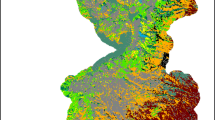Abstract
Tsuga heterophylla (western hemlock), a fire-sensitive, late-successional tree species, is an important component of old-growth forests in the Pacific Northwest, USA. In the Oregon Coast Range, however, T. heterophylla occurs at low densities in or is completely absent from many conifer stands. We used a cellular automata-based simulation model to explore the influences of the fire regime and gap disturbances on T. heterophylla dynamics at a landscape scale. The abundance of T. heterophylla in the simulated landscape was particularly sensitive to variation in fire return interval and fire severity. T. heterophylla was less sensitive to canopy gap return interval, probability of recruitment in canopy gaps, and the probability of rare long-distance dispersal events. Relatively short periods of high fire frequency caused a rapid and persistent decline in the amount of T. heterophylla in the landscape. Based on the simulation results, we propose two new hypotheses. The first is that landscape-level constraints imposed by the frequency, severity, and pattern of wildfires will limit the potential for gap-level processes to affect T. heterophylla regeneration patterns at the landscape scale. The second, related hypothesis is that legacies of cumulative fire effects will have a strong influence on the subsequent development of late-successional forest structure.
Similar content being viewed by others
Author information
Authors and Affiliations
Additional information
Received 29 August 2000; accepted 18 October 2001.
Rights and permissions
About this article
Cite this article
Wimberly, M., Spies, T. Landscape- vs Gap-level Controls on the Abundance of a Fire-sensitive, Late-successional Tree Species. Ecosystems 5, 232–243 (2002). https://doi.org/10.1007/s10021-001-0068-2
Issue Date:
DOI: https://doi.org/10.1007/s10021-001-0068-2




